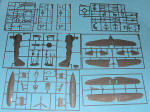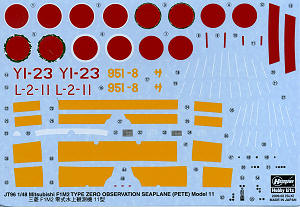
Hasegawa 1/48 F1M2 'Pete'
| KIT #: | 19196 |
| PRICE: | $48.00 SRP |
| DECALS: | Three options |
| REVIEWER: | Scott Van Aken |
| NOTES: | New mold kit (add $12 if you want the kit with the P.E.) |

| HISTORY |
The Mitsubishi F1M (Allied reporting name "Pete") was a Japanese reconnaissance floatplane of World War II. Between 1936 and 1944, 1,118 were built. Four were preproduction F1M1 aircraft as well as an unknown number of F1M2-K trainers. The Navy designation was "Type Zero Observation Seaplane" (零式水上観測機). (Not to be confused with the Zero fighter.)
The F1M1 was powered by the Nakajima Hikari MK1 radial engine, delivering 611 kW (820 hp), a maximum speed of 368 km/h (230 mph) and operating range of up to 1,072 km (670 miles) (when overloaded). It provided the Imperial Japanese Navy with a very versatile operations platform.
Optionally armed with a maximum of 3 x 7.7 mm machine guns (2 fixed forward-firing and one flexible rear-firing) and 2 x 60 kg (132 pound) bombs
The F1M was originally built as a catapult-launched reconnaissance float plane. However the "Pete" took on a number of local roles including area-defense fighter, convoy escort, bomber, anti-submarine, ocean patrol, rescue and transport. The type fought dogfights in the Aleutians, the Solomons and several other theaters. Though not really much of a 'ship buster', the PT 34 was sunk 9 April 1942 by "Petes". The "Pete" was highly maneuverable and not at all an 'easy kill', with many able to escape US fighters in the hands of a good pilot.
| THE KIT |
 Now
I know that this has been previewed before, but Dragon USA was kind enough to
send it so I thought you'd appreciate another opinion. Like all new Hasegawa
kits for the last 20 years or so, this one is designed to do multiple versions.
As there are not really that many different variants, Hasegawa will have to be
content with what differences there were during production. I know there are
differences as the kit does not include an F, H, I, or J sprue and there are
gaps that show where additional stuff could fit.
Now
I know that this has been previewed before, but Dragon USA was kind enough to
send it so I thought you'd appreciate another opinion. Like all new Hasegawa
kits for the last 20 years or so, this one is designed to do multiple versions.
As there are not really that many different variants, Hasegawa will have to be
content with what differences there were during production. I know there are
differences as the kit does not include an F, H, I, or J sprue and there are
gaps that show where additional stuff could fit.
Starting with the basic stuff, I should mention that Hasegawa does offer a photo etch set for this kit. It includes not only bits for the rigging, but most other aspects of the kit, including the interior. However, even without the p-e (which seems like minor embellishments to me), the cockpit and rear set are well detailed, lacking only belts to add that little bit extra. As is typical with Hasegawa, both raised detail and decals are given for the instruments. The dedicated can paint these while the lazy (that's me) will use the decals. There are a plethora of boxes and bits for the side walls, making photo etch even a bit redundant. All this will build into a complete tub that one can trap between the fuselage halves.
The wings have at least one half as full span so that will help eliminate dihedral issues. Clear bits are used for the various running lights. The struts, including the cabanes, are well molded and seem to be a simple fit. For those who wish to rig this one yourself, it would be a good idea to drill holes prior to closing the wings or fuselage. The locales are shown in the instructions, and truly, this is not a rigging intensive aircraft anyway. The kit provides bombs for under the wing and there is also a complete beaching gear to make it easier to display. A goodly amount of weight needs to be placed into the float prior to closing it up.
 The
instructions include assembling the kit with the photo etch bits, so things are
not as complex as they seem to those who decide against the additional expense.
The p.e. placement can be used for a rigging diagram as well. Three aircraft
options are provided, all of them in Mitsubishi Green over light grey. Gunze
paint references are given, of course. The yellow wing leading edge ID bands are
on the decal sheet and are in two widths. Aircraft options are the box art plane
based in the Solomons in 1942, another from 1943 in the same general locale and
the third is with the 951st Naval Flying Group in mid 1945. These are the 'new
era' decals with white whites and should work superbly.
The
instructions include assembling the kit with the photo etch bits, so things are
not as complex as they seem to those who decide against the additional expense.
The p.e. placement can be used for a rigging diagram as well. Three aircraft
options are provided, all of them in Mitsubishi Green over light grey. Gunze
paint references are given, of course. The yellow wing leading edge ID bands are
on the decal sheet and are in two widths. Aircraft options are the box art plane
based in the Solomons in 1942, another from 1943 in the same general locale and
the third is with the 951st Naval Flying Group in mid 1945. These are the 'new
era' decals with white whites and should work superbly.
| CONCLUSIONS |
Thanks to the myriad of units that operated this aircraft from both ship and shore stations, you'll be guaranteed to see multiple 'limited reissues' in the years to come. This new mold kit completely obsoletes the older Tamiya 1/50 kit which modelers have had for years. Besides, that kit from what has to be the late 1960s had several shape and detail glitches.
| REFERENCES |
May 2009
My thanks to www.dragonmodelsusa.com for the preview kit. Get yours at your local shop or on-line retailre.
If you would like your product reviewed fairly and quickly , please contact me or see other details in the Note to Contributors.